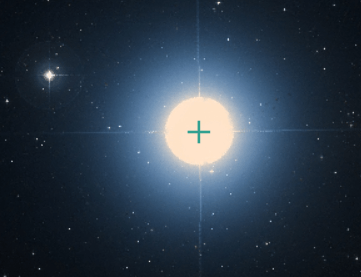Star of the Month
Alpha Piscis Austrini
AKA: Fomalhaut. Position: 22 hrs 57 min 39 sec -29 degrees 37 min 20 sec
Due south at 22:20 (BST) on 15 October 2020
Alpha Piscis Austrini (Fomalhaut)
Image: Simbad (http://simbad.u-strasbg.fr/simbad/)
Find a clear view to the south and look due south on an autumn evening. You will hopefully see a bright first magnitude star close to the horizon, which will look more like a second magnitude star as a result of extinction. This is Alpha Piscis Austrini or Fomalhaut, the most southerly bright star we can see in Havering as it is almost thirty degrees below the celestial equator and is never higher than nine degrees. In principle one should be able to observe a star such as second magnitude Theta Centauri (Menkent) which is 36 degrees below the celestial equator, but as it is never more than two degrees above the horizon it is impossible to see, not least because of extinction. In Havering Fomalhaut is a fairly uninteresting sight, but in southern Portugal it is much more impressive and makes a fine pair of bright stars with Beta Ceti (Diphda). However while it may be boring to look at, Fomalhaut is an interesting star. It is relatively close being 25 light years away and it is only 440 million years old. As it is twice as heavy as the Sun, it is also much hotter. Its main claim to fame is that it is ringed by four debris discs. The first disc is only 0.1 AU from the star and contains carbon grains, the second disc is 0.4 to 1 AU distant and there is a third disc at about 8 to 12 AU. The outmost disc is much further out at 133 AU and is board, being 25 AU wide. It is considered to be a possible protoplanetary disk. As we will see in later months, the study of protoplanetary discs has be revolutionised by the starting up of the Atacama Large Millimeter Array (ALMA) in 2013. With 66 antennae and operating in the 0.32 to 3.6 mm region of the radio spectrum, ALMA can produce very detailed images of protoplanetary discs and their chemical composition. Fomalhaut forms a binary star system with the variable star TW Piscis Austrini which is a flare star. It is 0.9 light years away from Fomalhaut. As a visual double, it is actually several degrees away from Fomalhaut, being a 6.5 magnitude star directly underneath it and about two-thirds of the way towards Delta Piscis Austrini.
